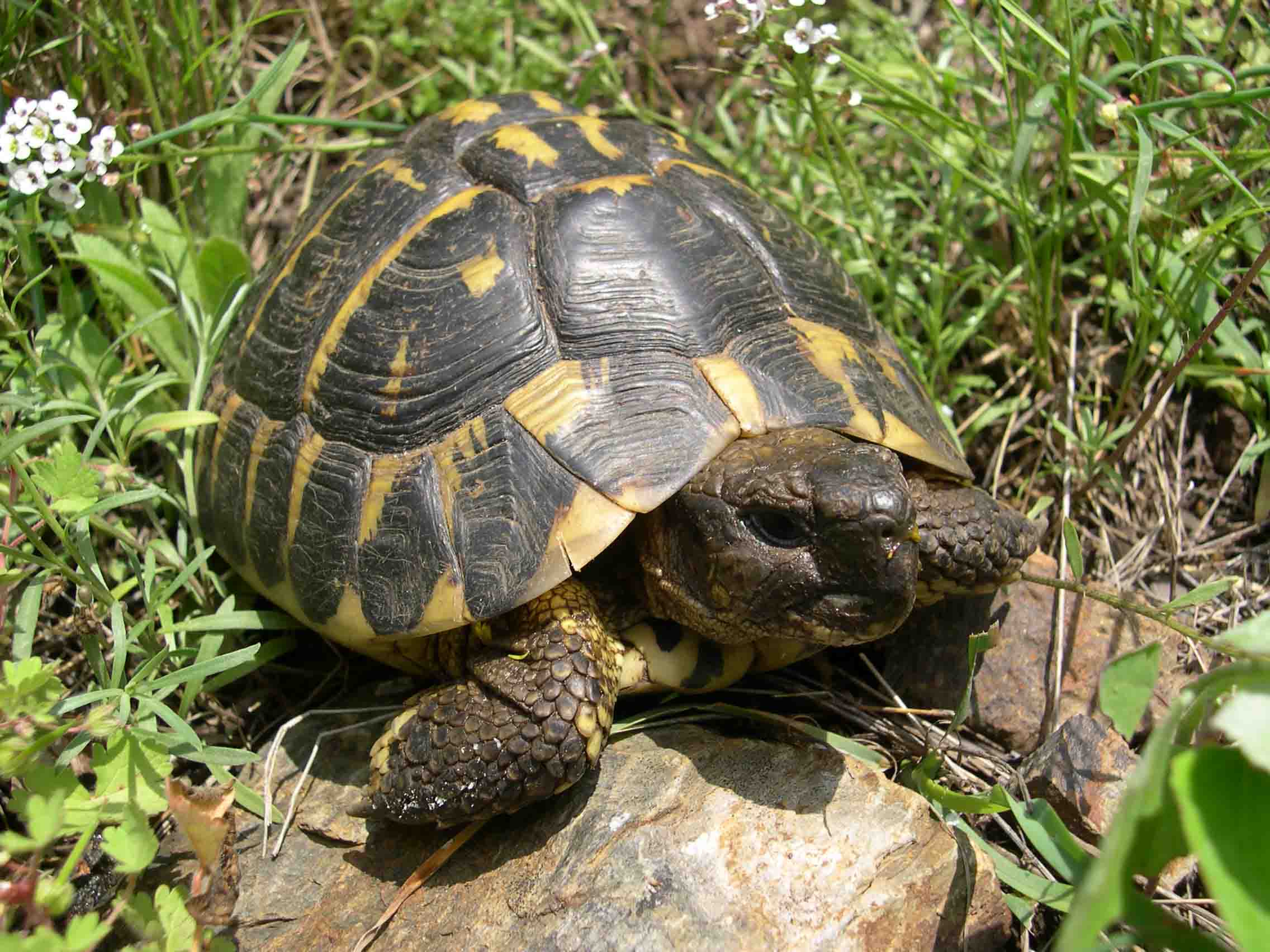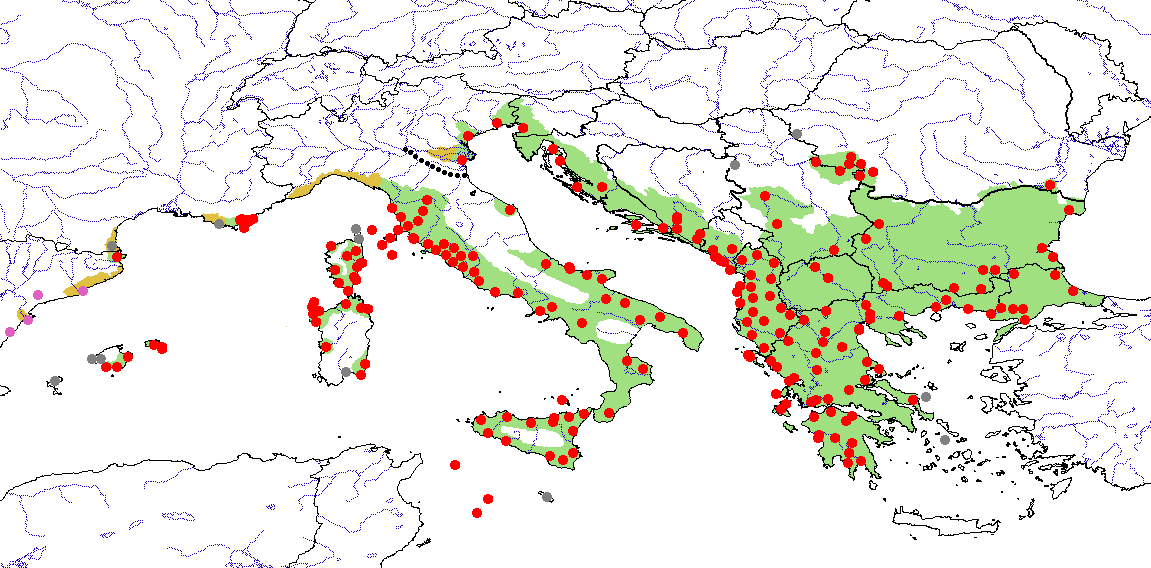Testudo hermanni, 059
Testudo hermanni (Gmelin 1789) –
Hermann’s Tortoise
Albert Bertolero1,2, Marc Cheylan3, Adrian Hailey4,
Barbara Livoreil5,6, and Ronald E. Willemsen7
1Associació Ornitològica Picampall de les Terres de l’Ebre, La Galera 53, 43870 Amposta, Spain;
2Present Address: Ecosistemes Aquàtics, IRTA, ctra. Poble Nou km 5.5,
43540 Sant Carles de la Ràpita, Spain [[email protected]];
3Laboratoire de Biogéographie et d’Ecologie des Vertébrés, EPHE-CEFE,
1919 route de Mende, 34293 Montpellier, Cedex 5, France [[email protected]];
4Department of Life Sciences, University of the West Indies,
St. Augustine, Trinidad and Tobago [[email protected]];
5SOPTOM–Centre for Research and Conservation of Chelonians, BP 24, 83590 Gonfaron, France;
6Present Address: Centre for Evidence Based Conservation, Bangor University,
Bangor, Gwynedd LL57 2UW, United Kingdom [[email protected]];
7Monte Cassinostraat 35, 7002 ER Doetinchem, Netherlands [[email protected]]
Summary. – Hermann’s Tortoise, Testudo hermanni (Family Testudinidae), is a medium-sized terrestrial species (average carapace length ca. 130 to 180 mm), widespread in the European Mediterranean region. Currently two subspecies are distinguished: T. h. hermanni in Western Europe and T. h. boettgeri in Eastern Europe, the border between them being the Po Valley in northeastern Italy. The species inhabits most Mediterranean vegetation habitats, but typically semi-open formations of stony, sun-drenched hills with low and sparse vegetation and grass. Some East European populations are found at up to 1300 m of elevation, but most populations are below 500 m. Sexual dimorphism is moderate, with females on average 12% larger than males. A morphological distinction from most other tortoise species is the presence of a horny claw-like scale at the tip of the tail that is more developed in males than in females. The maximum number of clutches laid annually is 3, but most frequent are 1 to 2 clutches per year. Maximum clutch size is 7 eggs for T. h. hermanni and 9 eggs for T. h. boettgeri, with a mean clutch size of 3.3 and 4.3 eggs, respectively. Annual survival of adults is estimated to range from 85 to 97%. Most western populations of the species are in strong decline and have very restricted distributions. Eastern populations appear to be more stable, though some populations also show a strong decline. Primary threats are destruction and alteration of habitats (mostly by forest fires, expansion of human settlements and infrastructure, and changes to traditional use of forest, pastoral practices, and agriculture), harvesting for the pet trade, and increases in the population size of native predators (mainly mammal carnivores and wild boars). Proposed conservation measures include habitat restoration and improvement, creation of reserves to protect the species, and environmental education. Captive breeding and reintroduction programs are necessary only for the most threatened populations.
Distribution. – Albania, Bosnia and Herzegovina, Bulgaria, Croatia, France, Greece, Italy, Kosovo, Macedonia, Montenegro, Romania, Serbia, Slovenia, Spain, Turkey. Fragmented distribution in southern Europe from northeastern coastal Spain and southern coastal France through much of Italy, and more continuous in the Balkan Peninsula, extending eastward to European Turkey. Distributed also in most western Mediterranean islands (Balearics, Corsica, Tuscan Archipelago, Sardinia, and Sicily) as well as some eastern islands (Ionian and Euboea).
Synonymy. – Testudo hermanni Gmelin 1789, Testudo hermanni hermanni, Protestudo hermanni, Agrionemys hermanni, Eurotestudo hermanni, Testudo graeca bettai Lataste 1881, Testudo hermanni robertmertensi Wermuth 1952.
Subspecies. – Two currently recognized: 1) Testudo hermanni hermanni (Western Hermann’s Tortoise) (synonymy: Testudo hermanni robertmertensi, Eurotestudo hermanni) (distribution: Western Europe from Spain through western and southern Italy); and 2) Testudo hermanni boettgeri (Eastern Hermann’s Tortoise) (synonymy: Testudo graeca boettgeri Mojsisovics 1889, Testudo boettgeri, Eurotestudo boettgeri, Testudo graeca hercegovinensis Werner 1899, Testudo hercegovinensis, Testudo hermanni hercegovinensis, Eurotestudo hercegovinensis, Testudo enriquesi Parenzan 1932, Testudo hermanni hermanni [in error]) (distribution: Eastern Europe from northeastern Italy to European Turkey).
Status. – IUCN 2011 Red List: Lower Risk/near threatened (LR/nt) (assessed 1996, needs updating); CITES: Appendix II, as Testudinidae spp., and Appendix A (European Community); Habitat Directive: Annexes II and IV; Berne Convention: Annex II.
Citation:
Bertolero, A., Cheylan, M., Hailey, A., Livoreil, B., and Willemsen, R.E. 2011. Testudo hermanni (Gmelin 1789) – Hermann’s Tortoise. In: Rhodin, A.G.J., Pritchard, P.C.H., van Dijk, P.P., Saumure, R.A., Buhlmann, K.A., Iverson, J.B., and Mittermeier, R.A. (Eds.). Conservation Biology of Freshwater Turtles and Tortoises: A Compilation Project of the IUCN/SSC Tortoise and Freshwater Turtle Specialist Group. Chelonian Research Monographs No. 5, pp. 059.1–059.20, doi:10.3854/crm.5.059.hermanni.v1.2011, //iucn-tftsg.org/cbftt/.
(Adobe Acrobat 6.0 or later required)

Adult male Testudo hermanni hermanni (CL = 141 mm) from Albera, Catalonia, Spain.
Photo by Albert Bertolero.
Distribution:

Distribution of Testudo hermanni in the Mediterranean Region; dotted line delimits the distribution of subspecies T. h. hermanni to the west and T. h. boettgeri to the east. Red dots = museum and literature occurrence records of native populations based on Iverson (1992), plus more recent and authors’ data; gray dots = extralimital occurrences reflecting escaped pets and/or erroneous or prehistoric records, or extirpated populations (e.g., southern France); purple dots = recently introduced populations; green shading = projected native distribution based on GIS-defined hydrologic unit compartments (HUCs) constructed around verified localities and then adding HUCs that connect known point localities in the same watershed or physiographic region, and similar habitats and elevations as verified HUCs (Buhlmann et al. 2009), and adjusted based on authors’ data; olive shading = native range extirpated in modern times.








